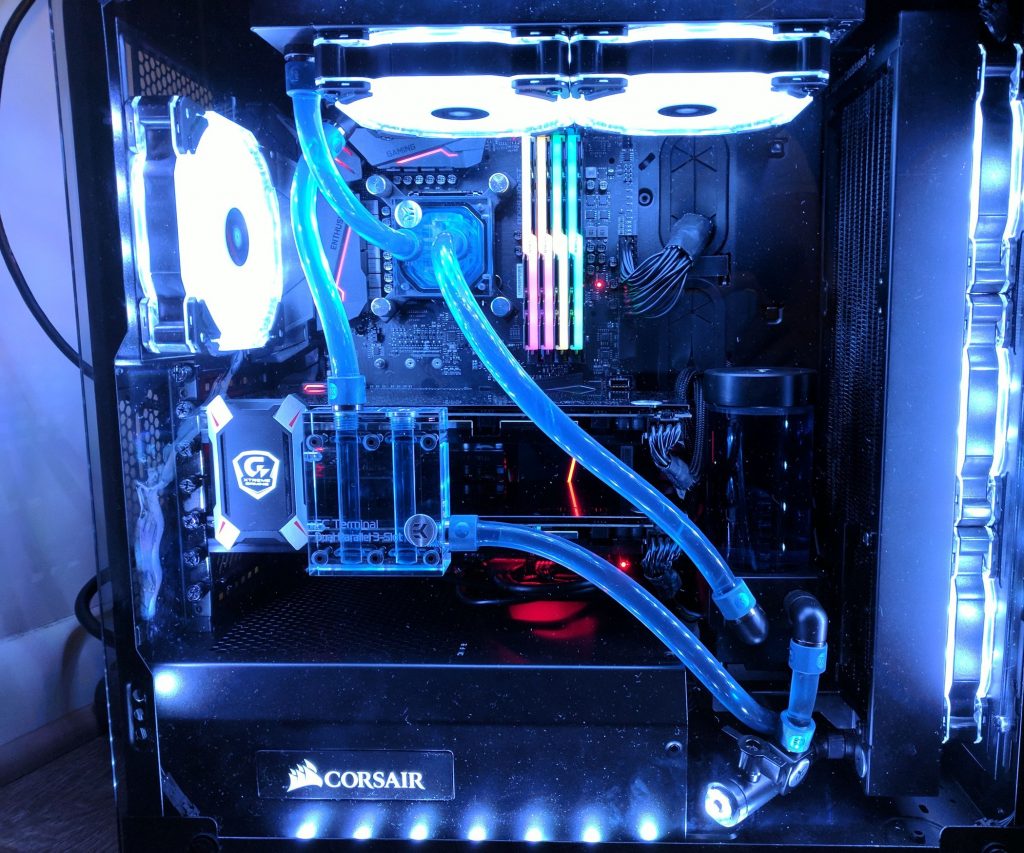Custom Water Cooling: Soft Tubing vs Hard Tubing
We have already discussed that custom water-cooling is not only one of the best way to keep your PC cool, but also one of the best ways to make your PC look amazing. With the right color scheme, fitting, tubing, and coolant, you can make your PC truly your own, and one of a kind as well. While it does have a few caveats, in more cases than one, the custom water-cooling comes on top.
However, we are not going to delve into the idea of this type of cooling as we did in our previous article. In this article, our focus is largely on the comparison of hard tubing vs soft tubing. This is certainly one of the topics that a lot of PC gaming and building enthusiasts talk about and it also has divided people ever since it became a thing.
There is no denying that both types of tubing have benefits and even downsides. That is what we are going to do in this article. Let’s look at how they are compared to each other.

Soft Tubing
The first type of tubing we have is the soft tubing. This is normally made out of PVC or polyvinyl chloride, and as compared to the other option, it is soft and more importantly, flexible to use. Soft tubing is generally suggested to those who are building their first custom loop as it is said to be easy to work with.
It is also sold by the name “vinyl tubing” and is available in solid colors, transparent, or in UV reactive colors. The benefits of soft tubing can be checked out below.
The Advantages of Soft Tubing
As far as the advantages of soft tubing are concerned, there are a few that you should be aware of. If you are trying to build your first custom loop, then going with this type of tubing might be a much easier job for you. Let’s have a look.
- Easy to Work With: One of the biggest advantages of soft tubing is that it happens to be one of the easiest to work with. You just have to go with the right diameter and the right fitting size and you are good to go. There is not a single process of bending them, heating them up in the proper way. You just buy them, cut them based on your need, and install them. Similarly, removing them is also one of the simplest, and best ways.
- Good for Beginners: I have stressed over this time and again; for anyone who is building their first custom loop, going with a soft tubing configuration is definitely the right way to go with. A lot of people think that it does not look as clean as hard tubing but if you plan the loop properly, and do not use excessive tubing, you can achieve some amazingly clean results.
- Affordable: Another thing is that when you are going with soft tubing, you are essentially saving money since this type of tubing is a lot cheaper as compared to hard tubing.
I have to be honest here, despite being one of the easier, soft tubings really requires a person’s interest. Are you looking for an easy way out and you do not care much about how your loop is going to end up looking? Go with this type of tubing.

The Disadvantages of Soft Tubing
It would not be fair to just ignore the downsides while only focusing on the good ones. Soft tubing does come with a few downsides that we are going to be looking at so the users can have a better understanding as to what they should go with.
- Aesthetics: One of the biggest downsides of soft tubing has to do with aesthetics. Sure, you can still make it look fantastic, but soft tubing will never look as good as its counterpart will.
- Clouding: One of the biggest issues with PVC pipes is that they can cloud over time. This is specifically a huge issue if you are going with transparent pipes. While the clouding won’t really do anything to the performance, it will start making the PC look less aesthetic to the eyes.
- Kinks: Another issue with soft tubing is that it can form kinks in some situations, which in return ends up restricting the flow of liquid, that results in the performance of the cooler dropping a lot.
Hard Tubing
Now that we know what the soft tubing is all about in terms of advantages and disadvantages, the next step is to shed light on hard tubing. For those who do not know, hard tubing or hardline tubing is made out of either acrylic or PETG. Users will have to buy these tubes, cut them to shape, and then bend them in order to install inside the case.
As with the soft tubing, the diameter of the tubes along with the appropriate fittings is required here, as well. With that said, the benefits of hard tubing are listed below for your convenience.
The Advantages of Hard Tubing
For those wondering, the benefits of hard tubing are certainly there, and in many cases, make people go for this type of tubing the most. Below, you can see what are the common benefits of this type of tubing. So, let’s not waste time and have a look.
- Great Shapes: Considering how you basically have to heat the tubes in order to bend them, you can shape them in truly unique and amazing shapes and then use them in your loop. I know it might not sound like much but it certainly gives your PC the oomph factor and makes it stand out.
- No Kinks: Another benefit is that thanks to the nature of the material, there is absolutely no chance of any kinks whatsoever. This is great since having kinks can and will drastically affecting the performance.
- No Clouding: If you care about aesthetics as much as you care about having performance and other similar factors, you would be glad to know that with hardline tubing, you will not have to worry about any clouding effect.
There you have it, folks! The advantages of hardline tubing over its competitors. Now we are going to take a look at some of the disadvantages.

The Disadvantages of Hard Tubing
I personally feel that the disadvantages of hard tubing are mostly subjective, wherein if you actually look past them, there is absolutely nothing wrong with this type of tubing. Still, I am going to mention what I think is wrong with hard tubing.
- Difficult to Work With: When it comes to hard tubing, you do not just have to cut it to size, but you also have to bend it and make sure that is of the proper size. Even a single millimeter of discrepancy can ruin the overall process. So, you really have to be precise with cutting and bending.
- Expensive: While on its own, the cost is not a lot. You can find either PETG or acrylic tubs for cheap, the issue is that since it requires trial and error, you should buy extra tubes in order to make sure you do not run out.
- Prone to Breaking: This normally happens during the heating and shaping process. There are moments where too much heat or bending can end up breaking the tube. Thankfully, you can buy a bending guide or tool to have the perfectly angled bends without any issues.
These are some of the well-known disadvantages of hard tubing.
So, Which One is Better?
Coming back to the question in concern. Which of these tubing is the better one? Well, depends on who you are asking, or who you are. There is no denying that hard tubing is superior thanks to cleaner looks and much better looks. However, it is difficult to work with.
On the other hand, the soft tubing is easier to work with but does not give you the same cleanliness as hard tubing.
To, conclude it; if you are someone who is building a custom loop for the first time, then going with soft tubing is the way to go because it is cheaper, it will allow you to easily work with the installation, and you will not run into many issues.
On the other hand, if you have patience, enough money, and the will to learn from the small mistakes, hard tubing is the way to go because, at the end of the day, it will look much better than the soft tubing.
Alternatives
If you don’t want to risk your newly purchased PC hardware then the perfect alternative for you intel platform CPU coolers can be these options, take a look at them here and explore the safer opportunities before going on the custom water looping journey.





